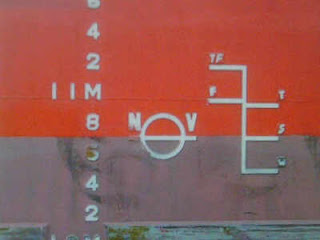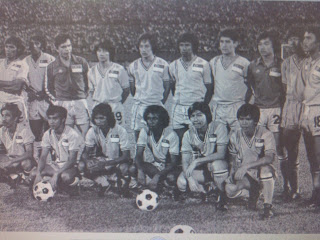Ships
When people asked me what I do for a living, I always tell them I'm in the Merry time business. The actual word is Maritime. I play a part in bringing goods to you, all kinds of goods including your cars, machinery, computers, TVs and really everything else. The Maritime industry is actually a very varied and huge one which when look at in totality includes logistics, warehousing and distribution, etc. plus many more types. In the maritime business, ships play a core part in the chain of things. We can lament about the stress and tough work we have to do but look at the seafarers and what they do and face on each voyage on a ship and being away from their families for long periods. Without these folks, the world will stand still. They are the unsung heroes of this world. I pray that God be with them. Here's who else but Barry Manilow with "Ships":
Captain Phil Harris
http://www.youtube.com/watch?v=xl3giUQQhoM&feature=related
http://www.youtube.com/watch?v=mCkx1My8Wqo
http://www.youtube.com/watch?v=CRO6H8puHF8&feature=channel
Phil Harris was an American Captain and part owner of a crab fishing vessel "Cornelia Marie" featured on Discovery Channel's "Deadliest Catch". He suffered a massive stroke and died shortly in February 2010. He was only 53 years old. He went fishing with his father from a young age and after high school worked unpaid for a year until he proved his worth. When he was only 21 he became one of the youngest captains of a crab fishing boat and later captain the Cornelia Marie for more than 20 years. Harris was married and twice divorced. He left behind two sons Jake and Josh who also worked on board the same vessel. Harris enjoyed fast driving and owned both a Harley-Davidson and a Chevrolet Corvette. He was a larger than life character and always showed courage and leadership, probably qualities needed in such dangerous, stressful crab fishing in the most treacherous seas. In it all, the most endearing part was when he talked about his wife, family and especially his two sons where he probably enjoyed his relationship with them working on board. When grown men, among the toughest out there cry for their beloved skipper: http://www.youtube.com/watch?v=3Lw3KjdnWrw&NR=1. Remember him and these folks each time you are enjoying Alaskan crabs.
Samuel Plimsoll
How many of you know Samuel Plimsoll? Samuel Plimsoll was a British politician and a social reformer. He is best remembered for having devised a Plimsoll line, which is a line on a ship's hull indicating the maximum safe draft for the vessel in various operating conditions. He learnt to sympathise with the struggles of the poor and when he had his good fortunes, he resolved to and was dedicated to improving their condition.
Coffin Ships
During the old days, unscrupulous owners put out un-seaworthy and overloaded ships while having them heavily-insured and risk the lives of their crew. These are called Coffin Ships. In 1868, Plimsoll endeavoured in vain to pass a bill in Parliament dealing with safe load on ships simply because Parliament at the time consists of many ship-owning MPs. He went on to publish his work "Our Seamen" which became well-known and some years later he accepted a bill that was passed which he thought was still inadequate. Plimsoll lost control when the bill was later dropped and he shook his fists calling members of the House villains.
The Struggle
Samuel Plimsoll carried a burden as he was aware of unthinkable dangers sailors faced as hundreds of seamen lost their lives at sea due to unscrupulous ship owners who in the pursuit of profits willingly put the lives of their fellow men at great risk. To maximise profit ships were loaded to the deck line often only to founder at sea. This made the owners even happier as they stood to gain more from insurance.
411 ships were reportedly sunken in 1873 alone which means hundreds of lives were lost. In those days, the law was lopsided and any man that has signed up could not back up even if he later knew that the ship was unsafe. The law favoured the rich shipowners. During those times, 1-in-3 prisoners was a sailor who refused to go on a voyage after signing.
Plimsoll had a mission and it was to make every ship have a load line to indicate that it was overloaded. When he got into Parliament, he began an intense campaign to save lives. He gave great and passionate speeches and wrote a book that shocked but won over many. The first "Un-seaworthy Vessels Bill" was passed in 1875 and soon after a bill written by Plimsoll was passed - it required a load line for all ships but there were vested interests and Parliament made a compromise allowing ship owners to put the line where they wanted.
Plimsoll was not disheartened as he fought on for another 14 years until it became law to ensure that the line was always set at a level that would ultimately ensure the safety of the ship and therefore, the crew. Over time, Plimsoll's load line became the international standard we now have today. Samuel Plimsoll is known as the Sailor's Friend. On the hull of every ship in any port in the world today you will see the Plimsoll line which indicates the maximum depth to which a ship can be legally and safely loaded. This is a tribute to all seamen who makes the world go round.
What Does Samuel &The Plimsoll Line Tells Us
Samuel fought for the poor and the abused. He could have a comfortable life like everyone else or join those unscrupulous businessmen for more money. He never gave up when the going was tough. He was ingenious. He had a mission. Today the Plimsoll line is everywhere not just as an international standard to safeguard safety limits and protect lives.
I believe this Plimsoll line can serve a greater cause that Samuel Plimsoll intended. Could we not learn from Plimsoll and put a Plimsoll line in all our endeavours to safeguard our own lives after all isn't life like navigating in the wide oceans? It will help us to identify our own SWL (Safe Working Limit). We will never navigate safely, go on a voyage or arrive at our destination in one piece if we don't have that. Don't you think?
Load Limits
What does load limits tell us? Ask an architect who needs to build a house, a tower building. Too much sand and too little cement, a wrong calculation or some who may use a temporary construction to prop up some defects can cause greater damage. Even a ship's deck has a certain allowable weight to withstand a certain concentration of cargo weight. Or a ramp way. Even a container has a weight specification.
People who do not care about this are unscrupulous as a grossly overweight container can come crashing down when the equipment assigned is overstretched or the floorboard might give way. Can the profit one makes pay for the death and loss of others? Load limits ask of us a simple question - how much is enough? How much load can you take?
How Much Is Enough?
How much time should we accord to each of our responsibility? How much time is devoted to family and how much to work? How much compensation is enough for us to work? How much to pay in order to satisfy our ego? How much does it costs for our own private time for reflection or deepening of our understanding of other things in life?
In our world of over-consumerism how do we set limits? Billboards, advertisements on TV, radio, the papers keep telling us to upgrade, acquire more, consume more you deserve it. Get it first pay later in interest free instalments. Plimsoll recognised way back and way before 1868 that there was a need for a load line on a ship so as to prevent it from getting overloaded. When overloaded a ship can capsize and lives would be lost. In short, it exposes our lives to ruin and destruction.
In a world of chronic consumerism, we are like navigating in an ocean. That requires us to set a safe limit. Materialism is a hazard like an iceberg where at first you only see the tip. Look what happened to the unsinkable Titanic. The Captain and the owners probably steamed at full speed without heeding the warnings and dangers ahead. All young people and in fact even some older ones out there must learn the skills of navigation because everybody tells you to upgrade and up size even at fast food outlets but nobody tells you to watch the limits.
Stability
We owed it to Samuel Plimsoll as the Plimsoll line of so many years ago has greatly enhanced cargo and crew safety. This also enables ships to stabilize. A ship with stability will counteract the tendency of it to pitch and roll especially when the seas are heavy. When ships can counteract their rolling motion in the ocean, they have stability. This will increase safety and comfort. We will also need stabilisers in life too when we could navigate carefully, watch the line of limit and have stability.
Whatever it is, I believe after reading this article, you will learn something new about shipping. That there was once upon a time a humble but great man like Samuel Plimsoll who taught us so much that he left us an indelible mark. Can we find more people like Samuel Plimsoll? If not what do we learn from him? Can we leave "our lines" in other fields or areas of life?
Watch this space as I shall expand from this subject into a Star Wars trilogy minus the light sabres. In the meantime, watch your Plimsoll line!




Comments